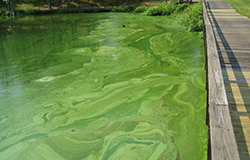Clean Water Current
EPA Releases Cyanobacteria Resources

EPA released a suite of online resource materials in early July, to assist public health officials and recreational water managers address the increasing occurrence of cyanobacterial blooms, or other harmful algal blooms (HABs) in freshwaters. Cyanobacteria, often referred to as “blue green algae,” is photosynthetic bacteria found ubiquitously in freshwater environments. When environmental and non-environmental conditions are ripe, these algae often form large blooms and can potentially release toxins into the water.
EPA’s resource materials aim to help water managers detect and respond to cyanobacterial blooms, identify potential human health risks associated with exposure, and make management decisions to reduce the occurrence of HABs. The materials also provide steps for water managers to prepare for future cyanobacteria blooms such as, prioritizing recreational waters based on risk, developing plans (e.g., response, monitoring, control and treatment), as well as posting signage and responding to media inquiries.
Coincidentally, in December 2016, EPA formally requested input from the scientific community on their Draft Human Health Recreational Ambient Water Quality Criteria and/or Swimming Advisories for Microcystins and Cylindrospermopsin. NACWA’s comments reflected the considerable implementation challenges for the municipal clean water community if EPA or states adopt numeric criteria values as ambient water quality criteria, and subsequently use these as the basis for wastewater treatment permit limits. NACWA emphasized that EPA should move forward with providing guidance to states on swimming advisories. It is unclear whether the resource materials released by EPA are in response to comments received.
For more information, contact Emily Remmel, NACWA’s Regulatory Affairs Director.